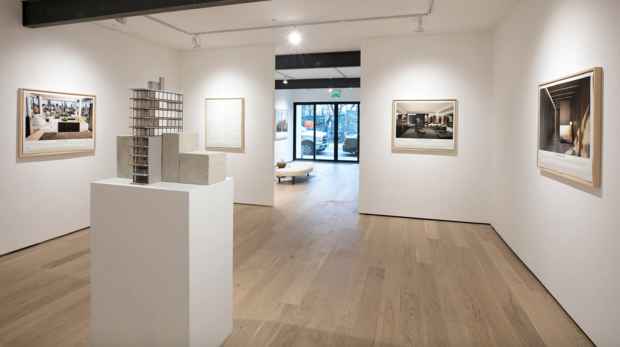Alexander Si “170 FORSYTH”
Ki Smith Gallery

This event has ended.
Ki Smith Gallery presents 170 FORSYTH, a solo exhibition by New York-based artist Alexander Si. Si’s multidisciplinary practice employs techniques of mimicry and simulation to investigate social and political impacts of contemporary product design, marketing, and pop cultural events. His second solo presentation in New York follows a 2022 intervention at Chinatown Soup, Sweetgreen, a full-scale recreation of the popular “fast casual” salad chain.
In December 2022, the Economist’s annual review named New York City the world’s most expensive metropolis, tied with Singapore. Raising new luxury high-rises in Midtown, developers now advance into Manhattan’s middle and lower-income neighborhoods, putting pressure on local populations and small businesses. City-wide rents increase alongside utilities, mortgages, groceries. New York’s preeminence in this category might seem overdue, yet it isn’t a surprise that it should happen during the presently aggressive post-pandemic recovery.
Several new boutique apartment buildings have arrived or are under construction in Manhattan’s Lower East Side and Chinatown. For his exhibition at Ki Smith Gallery, Alexander Si will install 170 FORSYTH, a mock showroom marketing a brand-new, ten-floor, five-unit luxury condominium. A mash-up of advertising copy, renderings, and saturated graphics used to sell actual apartments, the showroom comes equipped with a lounge, 3D scale model, floor plans, and high-resolution digital renders of the building’s interior and exterior. Of course, Si doesn’t plan to develop the property. If he did, Ki Smith Gallery and the residences above would be destroyed, replaced by wrap-around floor-to-ceiling glass windows, smooth wood interiors, and concrete accents, among other modern amenities.
A one-of-a-kind object might be called luxurious, or an item made with a rare material, a piece of furniture crafted with attention, sweat, and tears, “a drop of blood to heighten the sheen of the pearl.”* A chair made of curved cherry wood might be prized for the hours its builder spent heating, treating, and bending an otherwise dense material. Likewise, a connoisseur of artisanal crafts might rebuff the ordinary appearance of anything milled, manufactured, or cut with a CNC machine. Today, however, luxury also refers to the sleek glass surface of an iPhone, a clean white plaster wall, or the reflective depth of stainless steel, polished without any trace of a welder’s hand. In a way, Si’s work is a pun on contemporary elegance; he gives us the blood, sweat and tears. Striving for perfection in the surfaces of his final product, he only reveals himself as its maker. More lovely for being made by hand, 170 FORSYTH could also be labeled inferior, like a dress hand-stitched by a debutante to match haute couture.
Contra Store (1961), Claes Oldenburg’s Lower East Side storefront hawking messy knockoffs of everyday commodities, Si’s look-alikes channel aspirational drives. His earnest efforts to re-make common luxury items – bouclé fabric accent chairs modeled after Gwyneth Paltrow’s office, for instance – invoke an of-the-moment desire to enjoy life’s finer elements even if one can’t afford them. A New York Times trend-caster predicts a surge in “meta-fake” fashion in 2023, cheap thrift store fabric retooled into brash, conspicuous counterfeits of expensive items. Why not make a piece of furniture or an article of clothing that resembles the real thing, but give it a twist? In that sense, Si positions us to consider subtler aspects of mimicry, its potential to assert individuality, self-worth, and reversals of power.
Simple pleasures are interspersed among the glitzier accents, particularly in Si’s digital renderings. A pretty bowl of green apples, a spray of fresh flowers, a pair of reading glasses resting on the counter and other accessible additions tempt viewers to imagine how they might inhabit this space. For all that 170 FORSYTH interrogates conspicuous consumption, Si also invites us to indulge the domestic fiction he’s manifested. “Everything that goes beyond the simple fact of food, clothing, and shelter is luxury,” said Christian Dior at the end of World War II, ostensibly defining a shared tenet of a civilization worth defending, especially when the alternative is “guns and airplanes.” What is home without a little decor? A table for guests, well-proportioned dining chairs, a set of crystal glasses or ceramic tableware? 170 FORSYTH asks us to tease out answers to difficult questions. When does ornament enhance the aesthetic pleasure and comfort of a living space, and when is it a symbol of prestige, augmenting the status of its owner? What is luxury living, anyway?
*Jean-Paul Sartre on the work of Jean Genet, from “Masturbation” in Modern Times: Selected Non-Fiction, ed. Geoffrey Wall, trans. Robin Buss (1947) p. 115
- Kara Kazanoff
Media
Schedule
from January 21, 2023 to February 26, 2023